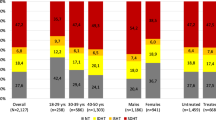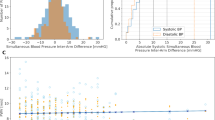Abstract
Office pulse pressure (PP) has been found to be independently associated with cardiovascular morbidity and mortality. While there is evidence that 24 h blood pressure (BP) is a better marker of the cardiovascular complications of hypertension than office BP, this information is still lacking in regard to PP. The aim of the present study was, therefore, to evaluate possible differences between office and 24 h PP in their relationship with cardiovascular risk profile. This cross-sectional study was performed in a group of 175 (104 M, 71 F) hypertensives (43 never treated before the study) free of clinical evidence of target organ disease. BP was measured at rest and during 24 h monitoring; cardiac structure and function was studied by ultrasounds; biochemical analyses were performed to evaluate some parameters of lipid and carbohydrate metabolism. Patients were divided into tertiles of office PP and of 24 h PP. Those in the highest tertile of PP had a significantly higher office and 24 h systolic BP along with a reduction in peripheral insulin sensitivity. Regarding cardiac structure and function, a significantly higher prevalence of concentric left ventricular hypertrophy (23 vs 55%; P=0.05) and an initial impairment of diastolic function with increase of the A wave was detected in hypertensives with higher PP. No difference between office and 24 h PP in detecting patients at higher cardiovascular risk was observed. In conclusion, office and 24 h pulse pressures were both able to segregate patients with a cluster of cardiovascular risk factors.
This is a preview of subscription content, access via your institution
Access options
Subscribe to this journal
Receive 12 digital issues and online access to articles
$119.00 per year
only $9.92 per issue
Buy this article
- Purchase on Springer Link
- Instant access to full article PDF
Prices may be subject to local taxes which are calculated during checkout


Similar content being viewed by others
References
Franklin SS et al. Hemodynamic patterns of age-related changes in blood pressure: the Framingham Study Circulation 1997 96: 308–315
Safar ME . Pulse pressure in essential hypertension: clinical and therapeutic implications J Hypertens 1989 7: 769–776
Pannier B et al. Pulse pressure and echocardiographic findings in essential hypertension J Hypertens 1989 7: 127–132
Zureik M et al. Cross-sectional and 4-year longitudinal associations between brachial pulse pressure and common carotid intima-media thickness in a general population: the EVA Study Stroke 1999 30: 550–555
Liao D et al. The prevalence and severity of white matter lesions, their relationship with age, ethnicity, gender and cardiovascular disease risk factors: the ARIC Study Neuroepidemiology 1997 16: 149–162
Kelly R, Hayward C, Avolio A, O'Rourke M . Non-invasive determination of age-related changes in the human arterial pulse Circulation 1989 80: 1652–1659
Smulyan H, Safar ME . Systolic blood pressure revisited J Am Coll Cardiol 1997 29: 1407–1413
Chae CU et al. Increased pulse pressure and risk of heart failure in the elderly JAMA 1999 281: 634–639
Madhvan S, Ooi WL, Cohen H, Alderman MH . Relation of pulse pressure and blood pressure reduction to the incidence of myocardial infarction Hypertension 1994 23: 395–401
Benetos A et al. Pulse pressure: a predictor of long-term cardiovascular mortality in a French male population Hypertension 1997 30: 1410–1415
Mitchell GF et al. for the SAFE Investigators Sphygmomanometrically determined pulse pressure is a powerful independent predictor of recurrent events after myocardial infarction in patients with impaired left ventricular function Circulation 1997 96: 4254–4260
Millar JA, Lever AF, Burke V . Pulse pressure as a risk factor for cardiovascular events in the MRC Mild Hypertension Trial J Hypertens 1999 17: 1065–1072
Verdecchia P et al. Ambulatory pulse pressure: a potent predictor of total cardiovascular risk in hypertension Hypertension 1998 32: 983–988
Friedewald WT, Lery RI, Fredrickson DS . Estimation of plasma low density lipoprotein cholesterol concentration without use of the preparative ultracentrifuge Clin Chem 1972 18: 499–502
Matthews DR et al. Homeostasis model assessment: insulin resistance and β-cell function from fasting plasma glucose and insulin concentrations in man Diabetologia 1985 28: 412–419
Celentano A et al. Cardiovascular risk factors, angiotensin-converting enzyme gene I/D polymorphism and left ventricular mass in systemic hypertension Am J Cardiol 1999 83: 1196–1200
Sahn DJ, De Maria A, Kisslo J, Weyman A . The Committee on M-Mode Standardization of the American Society of Echocardiography: Recommendations regarding quantitation in M-Mode echocardiography. Results of a survey of echocardiographic measurements Circulation 1978 58: 1072–1083
Devereux RB, Reichek N . Echocardiographic determination of left ventricular mass in man. Anatomic validation of the method Circulation 1977 55: 613–618
de Simone G et al. Left ventricular mass and body size in normotensive children and adults: assessment of allometric relations and impact of overweight J Am Coll Cardiol 1992 20: 1251–1260
de Simone G et al. Effect of growth on variability of left ventricular mass: assessment of allometric signals in adults and children and their capacity to predict cardiovascular risk J Am Coll Cardiol 1995 25: 1056–1062
Celentano A et al. Early abnormalities of cardiac function in non-insulin dependent diabetes mellitus and impaired glucose tolerance Am J Cardiol 1995 76: 1173–1178
Stergiopulos N, Westerhof N . Third workshop on structure and function of large arteries: part III. Determinants of pulse pressure Hypertension 1998 32: 556–559
Verdecchia P et al. Ambulatory blood pressure: an independent predictor of prognosis in essential hypertension Hypertension 1994 24: 793–801
James MA et al. Pulse pressure and resistance artery structure in the elderly Hypertension 1995 26: 301–306
Khattar RS et al. Longitudinal association of ambulatory pulse pressure with left ventricular mass and vascular hypertrophy in essential hypertension J Hypertens 1997 15: 737–743
Girerd X et al. Arterial distensibility and left ventricular hypertrophy in patients with sustained essential hypertension Am Heart J 1991 122: 1210–1214
Saba PS et al. Relationship of arterial pressure waveform to left ventricular and carotid anatomy in normotensive subjects J Am Coll Cardiol 1993 22: 1873–1880
Lind L et al. Left ventricular hypertrophy in hypertension is associated with the insulin resistance metabolic syndrome J Hypertens 1995 13: 433–438
Jain A et al. Left ventricular diastolic function in hypertension and role of plasma glucose and insulin: comparison with diabetic heart Circulation 1996 93: 1396–1402
Kamide K et al. Insulin resistance and cardiovascular complications in patients with essential hypertension Am J Hypertens 1996 9: 1165–1171
Guida L, Celentano A, Iannuzzi R, Ferrara LA . Insulin resistance, ventricular mass and function in normoglycaemic hypertensives Nutr Metab Cardiovasc Dis 2001 11: 306–311
Ferrannini E, Mari B . How to measure insulin sensitivity J Hypertens 1998 16: 895–906
Reaven GM . Role of insulin resistance in human disease Diabetes 1988 37: 1595–1607
Author information
Authors and Affiliations
Corresponding author
Rights and permissions
About this article
Cite this article
Ferrara, L., Guida, L., Innelli, P. et al. Clinic and ambulatory pulse pressure segregate a cluster of cardiovascular risk factors. J Hum Hypertens 16, 719–724 (2002). https://doi.org/10.1038/sj.jhh.1001476
Received:
Revised:
Accepted:
Published:
Issue Date:
DOI: https://doi.org/10.1038/sj.jhh.1001476



